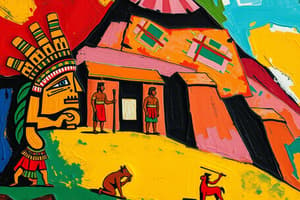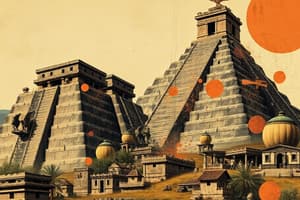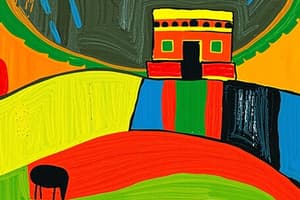Podcast
Questions and Answers
What physical obstacles did the Incas face in managing their empire?
What physical obstacles did the Incas face in managing their empire?
Their empire was built on a mountain range, there were rivers all around them, and messengers had to face tropical jungles on their journeys.
Who held the top position in the Incan class structure?
Who held the top position in the Incan class structure?
The emperor, called the Sapa Inca.
Who were the Capac Incas, and what jobs did they do?
Who were the Capac Incas, and what jobs did they do?
The Capac Incas were the highest ranking nobles and considered relatives of the Sapa Inca. Their jobs included controlling the empire's land and valuable resources, and holding important posts in government, the army, and priesthood.
Who were the curacas and what were some of their responsibilities?
Who were the curacas and what were some of their responsibilities?
To what class did most people in the Inca Empire belong and what kind of work did they do?
To what class did most people in the Inca Empire belong and what kind of work did they do?
Who owned the land each ayllu used?
Who owned the land each ayllu used?
What was the mit'a and how was it paid?
What was the mit'a and how was it paid?
How was the education of the sons of Incan nobles different from that of children of commoners?
How was the education of the sons of Incan nobles different from that of children of commoners?
At what ages did Incan men and women marry, and what were the typical steps to find a partner?
At what ages did Incan men and women marry, and what were the typical steps to find a partner?
Which god was the most important to the Incas and why?
Which god was the most important to the Incas and why?
Describe the types of sacrifices the Incas practiced in their religious ceremonies.
Describe the types of sacrifices the Incas practiced in their religious ceremonies.
How old were girls who were selected to become Chosen Women, and what did they learn?
How old were girls who were selected to become Chosen Women, and what did they learn?
What could happen to Chosen Women after age 15?
What could happen to Chosen Women after age 15?
What did the Sapa Inca do first when he wanted to include a new group in his empire?
What did the Sapa Inca do first when he wanted to include a new group in his empire?
What happened to groups that resisted inclusion in the Inca Empire?
What happened to groups that resisted inclusion in the Inca Empire?
What things did the leaders of groups that became part of the Inca Empire have to do?
What things did the leaders of groups that became part of the Inca Empire have to do?
What unique belief did the Incas have about the lands conquered by the Sapa Inca?
What unique belief did the Incas have about the lands conquered by the Sapa Inca?
Flashcards are hidden until you start studying
Study Notes
Physical Obstacles
- The Incan Empire was situated in a mountainous region, presenting challenges for management and communication.
- Rivers surrounded the empire, complicating travel for messengers.
- Messengers also navigated tropical jungles, further hindering swift communication.
Incan Class Structure
- The emperor, known as the Sapa Inca, occupied the highest position in Inca society.
- The Sapa Inca was believed to be a descendant of Inti, the sun god, granting divine authority to rule.
Capac Incas
- Capac Incas were top-ranking nobles, related to the Sapa Inca.
- They controlled the empire's land and resources, serving in key governmental, military, and religious roles.
- This group included governors for the empire's four quarters.
Curacas
- Curacas were local leaders from conquered groups.
- Responsibilities included tax collection, enforce adherence to Incan laws and customs, and spending time in Cuzco for educational purposes.
- They could only govern if they followed Incan traditions.
Common People
- Most inhabitants were commoners engaged in farming and herding.
- Commoners supported the government by producing goods and working on state projects, such as road building and weaving.
Ayllu Land Ownership
- Land used by each ayllu was owned by the emperor.
- Members cultivated this communal land for food and crops.
Mit'a System
- Mit'a was a public duty tax, requiring men to provide labor for government projects annually.
- Tasks included road repair, construction of storehouses, and mining work.
Education Disparities
- Commoners received no formal education, learning practical skills from elders.
- Noble children were educated by tutors in diverse subjects, including religion, geometry, history, military strategy, and public speaking.
Marriage Customs
- Incan men typically married in their early 20s, while women married around 16.
- Marriages usually occurred within an ayllu, often arranged by families or locally appointed curacas.
- Couples celebrated their agreement to marry by holding hands and exchanging sandals.
Worship of Inti
- Inti, the sun god, was the most revered deity due to connections with agriculture and the emperor's lineage.
- Agriculture was fundamental to Incan livelihood, linking Inti closely to their daily lives.
Religious Sacrifices
- Daily rituals involved priests offering corn to fire for auspicious agricultural conditions.
- Animal sacrifices, primarily llamas and guinea pigs, were common, alongside rare human sacrifices during critical events.
Role of Chosen Women
- Selected girls aged 8-10 trained in convents to uphold Incan religious traditions, prepare ceremonial food and drink, and weave garments for royalty.
- After age 15, some became temple workers, educators, or wives to nobles, while a few were sacrificed.
Inclusion Strategy
- The Sapa Inca preferred sending delegates to peacefully integrate new groups rather than declaring war.
- This approach emphasized the benefits of joining the empire, such as peace and prosperity, over conflict.
Resistance Consequences
- Groups opposing inclusion faced battles with the Incas, usually resulting in significant loss and land forfeiture.
Obligations of Conquered Leaders
- Leaders of newly incorporated groups were required to construct sun temples, acknowledge Incan deities, and study Incan laws and language.
- They returned to their communities as curacas after thorough education.
Beliefs about Leadership After Death
- The Incas believed deceased Sapa Incas continued to govern their conquered lands.
- New Sapa Incas expanded territories to manage this belief, leading to the creation of a vast empire as each emperor conquered new land.
Studying That Suits You
Use AI to generate personalized quizzes and flashcards to suit your learning preferences.




